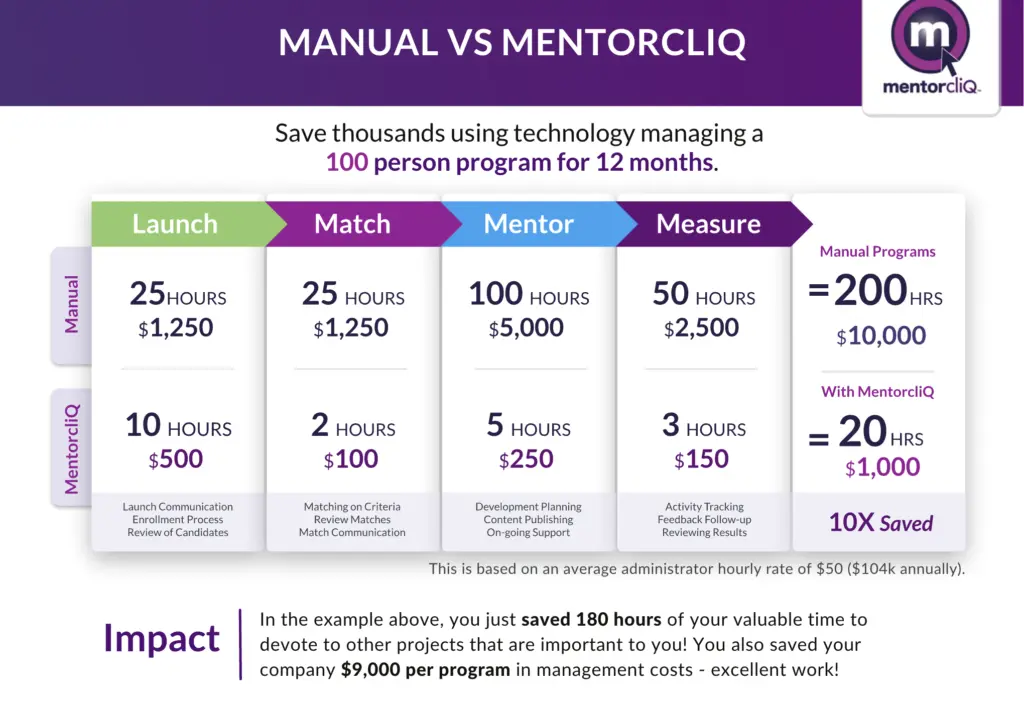The larger a company grows, the more complicated its organizational structures become. If you want to nerd out a bit and you have some free time, you can learn more about how Complexity Theory helps describe why that is. For HR and talent development leaders within these types of companies, that complexity often comes with significant challenges, especially when developing a mentoring strategy. Mentoring at matrix organizations requires more structure, planning, and executive support. Matching mentors and mentees, scaling programs, managing participant engagement, and measuring success grows exponentially more difficult.
Thankfully, navigating these highly structured organizations doesn’t require rewriting the book. Since most enterprise businesses have a matrixed structure, and 92% of Fortune 500 companies have visible mentoring programs, it’s clear the vast majority of industry-leading organizations have determined that mentoring can work in a matrixed structure. The key is understanding how to make it work effectively and equitably in a way that maximizes the impact for as many employees as possible.
What Is a Matrix Organization?
Matrixed work structures are by far the most common. In a 2018 State of the American Workplace survey, Gallup found that 84% of US workers operated within a matrix work structure to some degree. That’s beneficial to companies, as matrixed employees tended to be slightly more engaged. Yet matrixed employees are more likely to suffer from role ambiguity and ultimately struggle to understand how to properly navigate through their career without proper guidance nad mentorship.
At the simplest level, an organizational matrix is a type of management structure where employees have dual reporting relationships. Commonly, they’ll report both to the functional manager and the product manager. They’ll also work with multiple teams on multiple projects, exposing them to different functions, work styles, personalities, and skill sets.
There are some additional components that also help define a company operating as within a matrix structure:
Functional and project-based structures
The matrix model mixes the functional structure with the project-based structure. The functional structure provides a home to employees based on their functional expertise, like marketing, finance, or engineering. On the other hand, the project-based structure assigns employees to different projects based on organizational needs and priorities.
Keep this point in mind. When considering how to provide mentoring in a matrix organization, note that many employees will be working within their own function but also cross-functionally on different projects. That presents a unique opportunity to offer mentoring programs with a cross-functional focus that enhances and builds culture across your organization as well as cross-functional skill development.
Flexible resource allocation
In a matrix organization, resources are allocated based on project requirements and functional expertise. This flexible allocation allows for the efficient use of resources, as employees can be assigned to multiple projects based on the changing needs of the organization.
Ideally, your organization will understand the benefit that mentoring holds and properly allocate resources to the programs, as well. If you plan to scale mentoring and extend its reach across the organization, you’ll need to consider the additional costs associated with that, including time, technology, and human resources (such as additional admins to help run the program).
Improved communication
Matrix structures facilitate better communication and cooperation among different departments. By working together on projects, employees from various functions can share insights, knowledge, and expertise, fostering a culture of learning and continuous improvement.
Increased adaptability
The matrix organization model is designed to adapt quickly to changing market conditions. The dual managerial roles allow for faster decision-making and problem-solving, which is crucial in a dynamic and competitive market environment.
Skill development
Employees in a matrix organization have the opportunity to work on different projects and with different teams, which can significantly broaden their skill set and experience. This cross-functional working experience is invaluable in today’s multidisciplinary work environment.
However, companies shouldn’t rely on osmosis of skills just from that cross-functional engagement. Structured mentoring programs provide a guided and self-directed approach to that learning, where mentees can take ownership of the skills they want to develop.
Particularly when a company has an open mentoring program, employees can request mentors based on the skills those mentors possess that interest them and their desired personal development.
What Types of Mentoring Programs Work Best in a Matrix Organization?
No two companies are exactly alike, and that means the needs or types of programs that work best in your company will vary. That said, because of how matrix organizations are structured, some mentoring program types will be easier to establish and sustain long-term.
Take a mentoring network format, for example, such as group mentoring or mentoring circles. These formats allow mentees to access a range of perspectives and expertise. And because employees are already used to the cross-functionality of a matrix structure, they’ll be easily accustomed to and eager to participate in a circle, group, or even peer/team mentoring setup.
There’s no real restriction on the type of mentoring programs that work well within a matrix organization. You should make a few considerations before trying to launch or expand your programs within this format, however:
- Communication flow: In matrix organizations, there’s often a dual reporting system. This means mentees might be reporting to two or more managers. Make sure that the lines of communication are clear and that all parties involved are aware of the mentoring relationship. This can prevent any potential conflicts or misunderstandings down the line, especially when mentees are carving out time in their schedule to participate in mentoring engagements.
- Role clarity: Given the unique structure of matrix organizations, it’s crucial to define the roles and responsibilities of mentors and mentees clearly. Who is responsible for setting up meetings? Who provides feedback? Having clear guidelines can help streamline the mentoring process and ensure that everyone is on the same page.
- Flexibility: Matrix organizations thrive on flexibility. Your mentoring program should be adaptable to accommodate the changing needs and dynamics of the organization. This might mean having rotating mentors through different cycles, adjusting the cycle duration of mentorship programs, or even introducing virtual mentoring sessions to cater to remote teams.
- Goal setting: Establish clear, measurable goals for your mentoring program. This will not only provide direction but also help in assessing the success and impact of the program. Remember, in a matrix organization, data-driven decision-making is paramount. You will need to prove the ROI of your program, and that starts with clear and measurable goals that are tied to organizational needs like employee retention. By setting and tracking goals, you can leverage data insights to refine and improve the program continuously.
- Feedback mechanism: Regular feedback is vital for the growth and success of any mentoring program. Implement a system where both mentors and mentees can provide feedback about their experiences. This will help in identifying any gaps, challenges, or areas of improvement. Having the right technology in place makes this easier, which is why MentorcliQ’s customers love and rely on its built-in feedback reporting systems, such as QuickcliQs.
- Cultural alignment: Ensure that the mentoring program aligns with the company’s culture and values. This will foster a sense of belonging and make the program more appealing to potential participants. If the mentoring program doesn’t feel like a natural extension of the company’s ethos, it’s not going to work well in both attracting executive buy-in and sustaining interest from mentors and mentees.
- Training and resources: Offer training sessions for mentors to equip them with the necessary skills and knowledge. This can range from effective communication techniques to understanding the nuances of the matrix structure. Additionally, provide resources such as reading materials, webinars, or workshops that can aid both mentors and mentees in their journey.
Mentoring in a matrix organization can thrive and offer immense value to all participants, but only when it’s developed outside of a bubble. E.g., consider all of the external needs and impacts and grow the program in a way that meets existing needs and aligns with expectations. That doesn’t mean there’s no room for innovation and experimentation, of course. You’ll just need to justify how your unique approach aligns with your company goals, culture, and budgetary considerations.
How to Structure and Scale Mentoring at a Matrix Organization
Although 92% of Fortune 500 companies have mentoring programs, that doesn’t mean those programs are universal across the organization. Even many leading companies still take a manual approach to mentoring, which severely limits the potential impact of those programs. There are several key factors standing in the way of wider adoption of mentoring programs at matrix organizations:
- Complex reporting lines: Those complex hierarchies and multiple manager reporting requirements we mentioned earlier can create numerous challenges for mentoring program administrators. You may struggle to determine who should mentor whom, and you may encounter more potential conflicts of interest. Ensuring transparency and clear communication is essential to navigate these complexities.
- Diverse skill sets: Given the cross-functional nature of matrix organizations, employees possess a wide range of skills and expertise. Matching mentors and mentees based on skills, goals, and areas of development can be a daunting task without software-enabled matching tools.
- Geographical dispersion: Matrix organizations often span multiple locations, sometimes even globally. This geographical spread can create challenges in coordinating face-to-face mentoring sessions. Virtual mentoring becomes crucial in such scenarios, but it also requires a robust technological infrastructure to support it.
- Cultural differences: With employees from various backgrounds, cultures, and departments, creating a cohesive mentoring culture can be challenging. Ensuring that the mentoring program respects and incorporates these diverse perspectives while fostering a unified mentoring ethos is crucial.
- Lack of automated systems: Manual matching of mentors and mentees can be time-consuming and may not always yield the best pairs. Leveraging technology, like algorithm-based matching systems, can streamline this process, ensuring more compatible and productive mentoring relationships.

Book a demo to see what mentoring software looks like up close and personal!
- Inadequate training: Not everyone is naturally equipped to be a mentor, and that’s OK. Without proper training and resources, however, even the most well-intentioned mentoring relationships can fail. Organizations need to invest in training programs that equip potential mentors with the necessary skills to guide their mentees effectively.
- Scalability concerns: As the organization grows, so does the need for a more extensive mentoring program. Without a clear strategy for scaling, the program can become unwieldy and less effective. This involves not just expanding the number of participants but also ensuring the quality of mentorship remains consistent.
- Measuring success: Without clear metrics and KPIs, it’s challenging to gauge the success of a mentoring program. Matrix organizations, with their emphasis on data-driven decision-making, need a robust system to track the progress, outcomes, and overall impact of their mentoring initiatives.
To effectively structure and scale mentoring in a matrix organization, companies need to address these challenges head-on. By leveraging technology, offering training, ensuring clear communication, and setting measurable goals, organizations can create a mentoring program that not only meets the unique needs of a matrix structure but also offers tangible benefits to its participants.
Almost Everyone’s Matrixed, But Not Everyone’s Mentored
Perhaps the biggest problem we touched on in this post combines these two points:
- Most people are matrixed to some degree at their companies
- People working within matrixed organizations are more likely to be unclear or unsure about their role and career progression
As Gallup explained in a blog post, Too Many Teams, Too Many Bosses: Overcoming Matrix Madness:
“Overburdened matrixed teams pose a risk to their members’ performance and wellbeing. Often, the root cause(s) of these problems can be traced back to three obstacles:
- cognitive overload
- role conflict and role ambiguity
- coordination problems”
How can employees in that context find the time to grow and their role? Simple: they can’t. Not unless their company strongly prioritizes learning and development. That only happens with a structured, dedicated approach that’s as seamless as possible for participants and admins alike. Unfortunately, manually running such a program is effectively impossible within a highly matrixed organization. The more complex the organizational structure is, the more complex the mentoring program will be.
It’s a fact of life. But it’s also a problem where solutions already exist.




